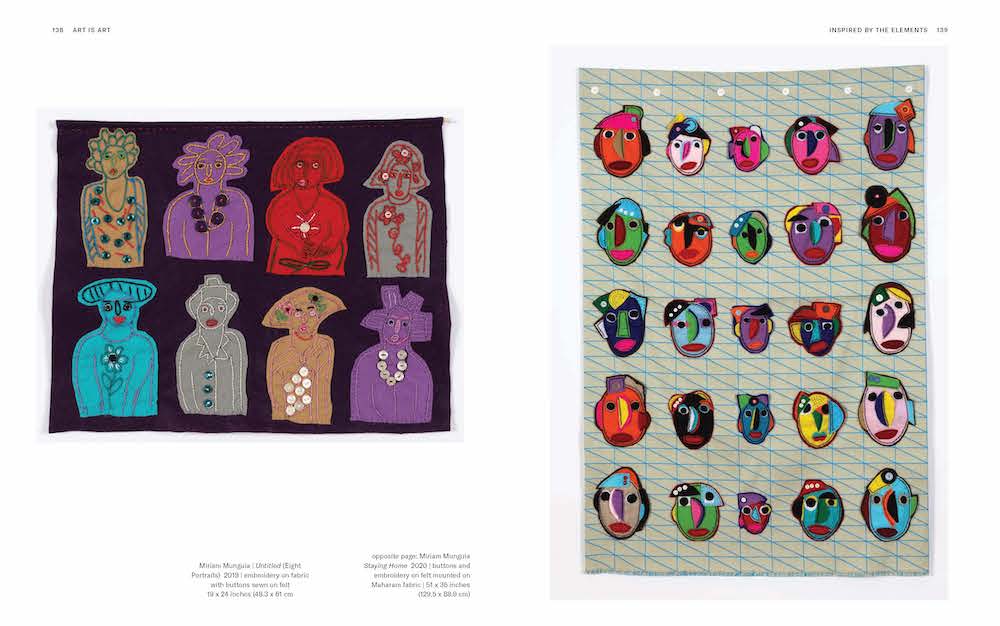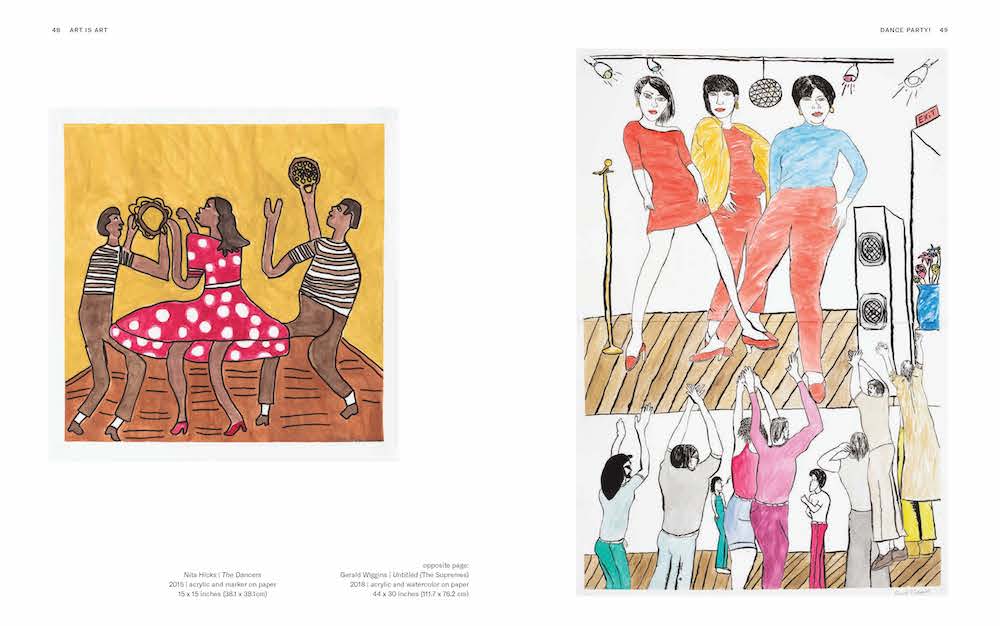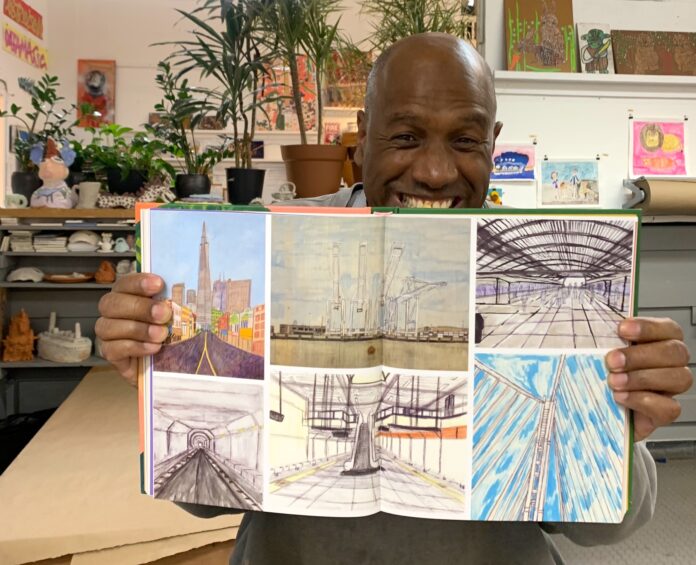The simple title of a new book, Art is Art, is unexpectedly provocative. Isn’t it equally true that words are words? After all, they are but marks on a page or screen, phonetics cast into the air, patterned bumps on paper for people with limited or no ability to see, or hand gestures for people whose hearing is impaired. It is only when they are thrust into service as weapons, wonderments, tools, that words and art alike begin to convey meaning.
And so it is that a marvelous book filled with both becomes the ideal way to honor the milestone 40th anniversary of Creativity Explored, a nonprofit that links people with developmental disabilities to the opportunity to express themselves through art, and share their work with diverse audiences. The 368-page book, published by Chronicle Books and edited by CE’s director of arts partnerships Ann Kappes features hundreds of original paintings, drawings, illustrations, and sculptures. The accompanying text carves deeply into the individual and shared experiences of the neurodiverse and determined artists represented in the book’s 40 themed chapters.

The first of these introduces the organization’s “person-centered thinking” (PCT) approach that supports Creativity Explored’s 130-plus artists who have collectively earned over $2 million from their sales, licensing, royalties, workshops, and speaking arrangements through the group. This essay declares that the surging disability justice movement is powerful and essential not only within, but beyond, the walls of an artist’s studio. Society benefits when PCT prevails and every person is valued, and allowed expression, uplifting all of us.
If there is one passage from Art is Art that epitomizes that which makes Creative Explored unique and exceptional, it is found in chapter 10, which is titled, “We Could Kiss, and We Could Look at the Moon.” Artist Zachary Adams uses markers to inscribe his tender, personal missives about love and romance onto brown paper bags, embellishing them with soft-edge geometric shapes in acrylic paint. But he found himself self-conscious creating in front of others. His teacher thought to construct a cardboard box barrier around his work station in the art studio to allow Adams to compose his life-dream messages in privacy. Shielded during the crucial art-making stage, creativity bloomed for the artist who, in granting permission for the publication of his art, breaks free of all boxes and barriers. The world cannot bear that the artwork of Adams and other neurodiverse artists be hidden.
In an interview with 48hills, Kappes speaks about the CE community and the forces that brought her to the position she holds.
“Creativity Explored is like a magnet. It just attracts people who appreciate visual art, humanity, and social justice issues. Sometimes it’s the art that’s the gateway, sometimes it’s the individual artists. There’s a deep connection to the art itself,” she says. “The variety of work, all artists creating in their own style; it’s an embarrassment of riches and there’s constantly something new.”

When it came time to select a collaborative publishing partner for the book, it was important to the team to pair with a local editorial, but also with one with a celebratory approach would lean towards CE’s typical quirkiness and freedom. A former CE gallery associate had moved on to work as a graphic designer at Chronicle Books, and a board member with a connection provided a second thread to the publisher. Kappes says “it was a great match.”
The book’s process was aided tremendously by the thick archive of CE’s image database, which holds roughly 30,000 images and robust documentation of exhibits and artists’ portfolios. Although many of the book’s chapters are structured around past exhibits, several were intentionally created to demonstrate the diversity of the organization’s work.
Help us save local journalism!
Every tax-deductible donation helps us grow to cover the issues that mean the most to our community. Become a 48 Hills Hero and support the only daily progressive news source in the Bay Area.
Kappes says, “’Inspired by the Elements’ is one chapter we added that features three artists who come from a country other than America. We pulled stories from their initial histories that continue to be important to their art. It was a theme we wanted to convey that we’ve not had an exhibition on. There are also artists who don’t use traditional language, so that caused the ‘I Speak With My Art’ chapter. They express their thoughts through their art in that chapter.”
The Mail Art Club spotlighted in chapter 3 came to life during the pandemic in three exhibitions. Engaging with artists and caretakers via Zoom, staff and instructors worked hard to make remote art-creation possible. However, some artists did not have access to the internet. A solution was found that offered unexpected benefits after customized kits were sent to artists with postcard-sized paper, pencils, pens, rubber stamps, and other materials, along with stamps for postage. Their astonishing results had hundreds of mail art pieces whizzing through post offices to reach an ever-widening circle that included staff, fellow artists, teachers, friends, family members, and more.

“We had a former volunteer who is now an artist in France join in. It’s still a popular class and the project continues,” says Kappes.
Two other chapters, one highlighting artists who work with animation, the second about artists interested in using found objects, prove the fearless, investigative mindset of artists at CE. A vibrant digital arts program serves artist who thrive on computers, but would never dream of picking up a paint brush. Kappes says the digital artwork shown in the book runs directly counter to the stigma that artist with developmental disabilities who cannot work in the tech industry.
In collaboration with Recology, formal residencies were offered in 2022 to artists specializing in found art. Teachers were trained by the Recology staff in how to collect materials, and artists were allotted six months instead of the usual three months to work on large-scale pieces in Recology’s nationally recognized residency program.
“They treated our artists like any others, in that they expected the same things from them, but also, they adapted the structures to accommodate the program to recognize the artists’ needs,” Kappes says. In some ways, Recology’s program was not novel, picking up on CE’s longstanding practice of using found materials. At one point, someone donated a VW car hood and John Patrick McKenzie drew on it using his signature font.
“The found art chapter shows how creative our artists are who will make art on car hoods, beads, windows, pieces of wood, almost anything.”

It’s hard not to mention the book’s every chapter. “Exposed” bursts with explorations of the human form and sexual identity. Other sections tap into nonconformity, social or political commentary. References to well-known artists are sprinkled deliberately throughout the book. According to Kappes, that’s to validate the place of CE artists’ work in the canon. She calls attention to the worldwide Art First movement’s emphasis on recognizing artists by achievements first, not by their diagnosis. The true measure of success lies in the quality of the work. Ultimately, it all comes back to art being art, and human imagination being liberated from past barriers. The message is clear: Don’t miss the train. CE’s journey is available to all, from professional artists to casual observers.
Kappes says, “There are more and more centers like ours and overall, there’s greater interest in society in people with disabilities. There’s also greater influence of artists and others with disabilities because they’re no longer hidden in institutions, and because art usually leads conversations about the accomplishments of people, and isn’t centered on disabilities. We say art is a great gateway, a way to be curious, to set up a productive, inclusive, and celebratory viewpoint. There are so many labels put on artist with disabilities and we want to get beyond labels and refer to it as what it is: art is art.”
Purchase Art is Art here.




